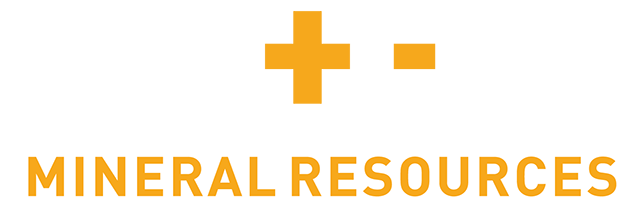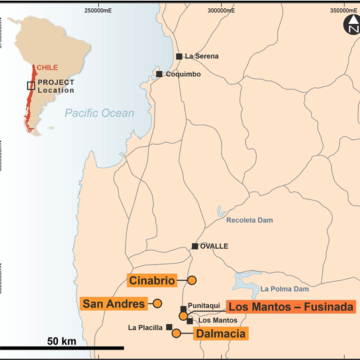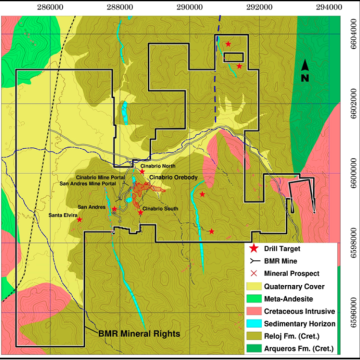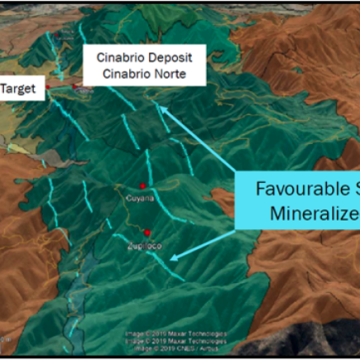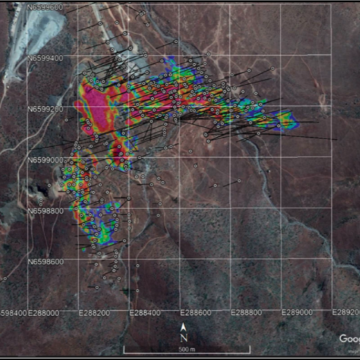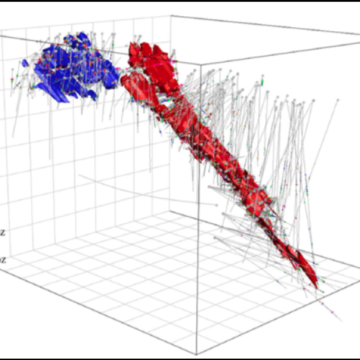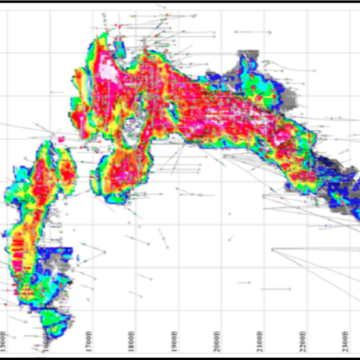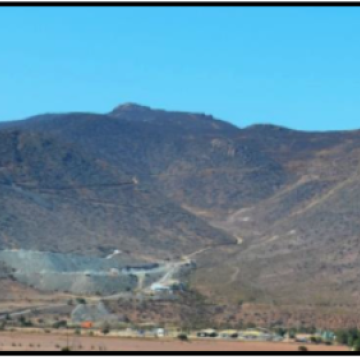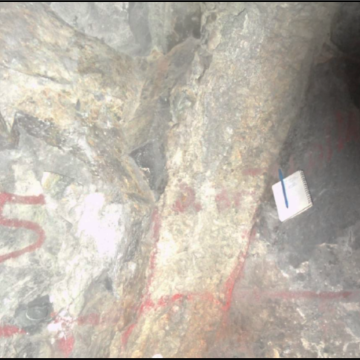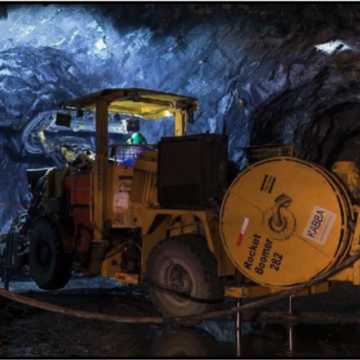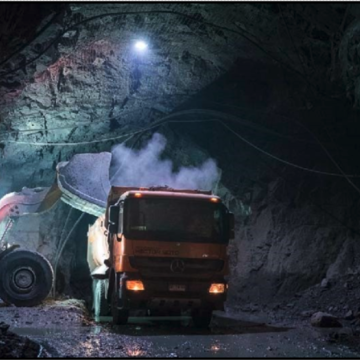Battery Mineral Resources (“BMR”) 100%-owned Punitaqui copper mine operation leverages all necessary fixed assets and infrastructure, excellent road access, ready availability of water, existing power lines, operational permits in place, and widespread mineralization. Punitaqui boasts a nine-plus year operating history.
After acquiring the assets in March 2021, BMR begin redevelopment of the operation and on May 13th, 2024, BMR announced the resumption of copper concentrate production.
The timeline from first fresh mine feed through the mill to reaching planned capacity is expected to require approximately nine months, reaching a run rate of ~90,000 tonnes per month. BMR expects that the Punitaqui full annual copper production rate will be in the range of 19 million to 23 million pounds of copper in concentrate with an operating margin of $35 million to $50 million at current copper prices.
Cinabrio is the original underground mine which was the source of feed to the copper concentrating plant for over eight years and has remaining ore to be processed. The San Andres zone has existing underground access and copper mineralization up to 30 meters wide. The Dalmacia zone also has underground access and exhibits copper mineralization widths up to 50 meters. Regional targets including the Cinabrio Norte zone offer near-term “blue sky” exploration and district-scale potential for BMR.
While the Cinabrio and San Andres mines are reaching full production, BMR will continue processing mill feed from outside sources and advancing toward its newly discovered Cinabrio Norte zone, to commence production of mill feed from that zone in H2 2025.
As part of the ongoing operational readiness during 2024, BMR is executing underground infill and extensional drilling at San Andreas and Cinabrio. The drilling program is designed to further define areas that could be included in near-term mine sequencing and for grade control purposes. BMR looks forward to reporting the results of this drilling during the course of the year.
Battery Mineral Resources (“BMR”) 100%-owned Punitaqui copper mine operation leverages all necessary fixed assets and infrastructure, excellent road access, ready availability of water, existing power lines, operational permits in place, and widespread mineralization. Punitaqui boasts a nine-plus year operating history.
After acquiring the assets in March 2021, BMR begin redevelopment of the operation and on May 13th, 2024, BMR announced the resumption of copper concentrate production.
The timeline from first fresh mine feed through the mill to reaching planned capacity is expected to require approximately nine months, reaching a run rate of ~90,000 tonnes per month. BMR expects that the Punitaqui full annual copper production rate will be in the range of 19 million to 23 million pounds of copper in concentrate with an operating margin of $35 million to $50 million at current copper prices.
Cinabrio is the original underground mine which was the source of feed to the copper concentrating plant for over eight years and has remaining ore to be processed. The San Andres zone has existing underground access and copper mineralization up to 30 meters wide. The Dalmacia zone also has underground access and exhibits copper mineralization widths up to 50 meters. Regional targets including the Cinabrio Norte zone offer near-term “blue sky” exploration and district-scale potential for BMR.
While the Cinabrio and San Andres mines are reaching full production, BMR will continue processing mill feed from outside sources and advancing toward its newly discovered Cinabrio Norte zone, to commence production of mill feed from that zone in H2 2025.
As part of the ongoing operational readiness during 2024, BMR is executing underground infill and extensional drilling at San Andreas and Cinabrio. The drilling program is designed to further define areas that could be included in near-term mine sequencing and for grade control purposes. BMR looks forward to reporting the results of this drilling during the course of the year.
Punitaqui - Cinabrio Deposit
Key Facts
-Cinabrio Pillars – 1,027,000 tonnes indicated at 1.51% Cu at a 0.7% Cu cut off.
Note: Historic work at the Cinabrio Mine did not include silver analyses therefore silver grades are assumed to be at a null grade for the purpose of completeness however, it is reasonable to assume that silver grades will be at a similar tenor as Cinabrio Norte.
Overview
The Cinabrio underground copper mine is located about 120km from La Serena in Region 4 of Chile. The Property is about 12km south of the city of Ovalle, which is the capital of the province of Limari, Coquimbo region. The access from the city of Ovalle is by route D-605, which links the city with Punitaqui.
From 2007 - 2010, Tamaya Resources Limited, undertook a Feasibility Study, constructed a processing plant, and attempted to put the mine in production. In 2010, Glencore International Plc acquired the project upgraded plant & the underground development of Cinabrio. In 2018, Xiana Mining Inc. negotiated the acquisition of the operating Punitaqui mine from Glencore. Xiana operated the mine for approximately 18 months until the mine was idled due to low copper prices.
The Cinabrio mine has been on "care and maintenance" since April 2020 when the previous operators were forced into bankruptcy by its creditors due to the rapid fall in copper prices. Historically the Cinabrio deposit has been the main ore feed for the processing plant and has fed the plant nearly 9 million tonnes of ore.
Mining is generally sublevel open stoping and ground conditions are generally good with limited bolting and other support. Historically, mining has been performed by underground contractors.
The host of mineralization at Cinabrio is a package of sedimentary rocks that occurs above a sequence of andesitic volcanic and sediments derived from those volcanics during the early stages of a marine transgression. The sedimentary package includes calcareous sandstones and conglomerates with intercalated calcareous black shales and carbon bearing fine grained sandstones.
This package averages around 15m in thickness. Geological evidence from drill core and underground mapping suggests that copper mineralization including chalcopyrite and bornite was emplaced by feeder structures into the host sedimentary horizon just after sequence was deposited. Mineralization occurs as both massive and disseminated with higher-grade copper associated with bornite rich zones.
Historical Background
A series of exploration programs undertaken at Cinabrio began with the United Nations project called "Ovalle South Mining Survey" (1965). The site has been worked since 1968 in interrupted periods, by local miners focussed on the exploitation of near-surface copper oxide mineralization.
In 1965, a geophysical study of induced polarization was conducted and subsequently 141m of diamond drilling was completed at Cinabrio.
In 1972, nineteen diamond drillholes were completed, totaling 630m. The drilling was followed by the development of a portal and the main adit tunnel to access the 410m level. The underground development was 130m in length and 4.5m in height x 4.0m in width.
The Cinabrio property was acquired by CMC (a private Chilean mining company) in July 2004, which completed an engineering study to outline an underground mining plan utilizing sublevel stoping.
From 2007 – 2010, Tamaya Resources Limited, undertook a feasibility study, constructed a copper ore processing plant, and commenced mining. In 2010, Glencore International Plc acquired the project out of bankruptcy from Tamaya, upgraded the plant and the underground development at Cinabrio. In 2018, Xiana Mining Inc. acquired the mine and plant from Glencore Plc, increased exploration efforts and began initial development of the San Andres zone until it announced a temporary shut down due to low copper prices in April of 2020.
Drilling on the Cinabrio deposit by our predecessors consists of 255 diamond drillholes, 173 reverse circulation (RC) holes and seven blast holes (BH) for a total of 467 holes with a combined meterage of 73,893m and a total of 19,059 samples taken and analysed. In addition, 10,966 underground channel samples were taken during mining.
Geology & Mineralization
Cinabrio is an Iron Oxide Copper Gold (IOCG) type manto deposit. Mineralization has a strike length of about 750m, is up to 30m thick, and is very continuous to a vertical depth of at least 700m. The mineralization is of predominantly massive and disseminated chalcopyrite, bornite and pyrite. The host stratigraphy and mineralization dips steeply to the east with limited syn and post-mineralization faulting. Five hundred meters to the southwest is the San Andres zone, which is the faulted offset of the top of the Cinabrio orebody.
Historically, the Cinabrio deposit was the main ore feed for the copper ore processing plant for eight-plus years.
The regional geology of Jurassic to Lower Cretaceous age consists of a sequence of volcanic rocks (lavas, conglomerates and andesitic breccias) with interbedded marine sediments (shales, fossiliferous limestones, and thin layers of sandstones). This sequence is affected by a granitic intrusive (diorites - granodiorites) of Upper Cretaceous age.
The manto mineralization at Cinabrio is hosted by a regionally extensive marine sedimentary rock unit within an andesitic volcanic sequence. The sedimentary rock unit is comprised of dark coloured shales, volcanoclastic sandstones, volcanoclastic sedimentary breccias, conglomerates and fossiliferous limestones.
The structural framework of Cinabrio is very similar to that of the district and consists of north-south, northwest-southeast, and east-west trending structures. There is a strong structural control on copper mineralization at the Cinabrio mine. The sedimentary unit that hosts the copper mineralization is deformed and rotated by extensional faulting resulting in multiple structural repetitions of the mineralized sedimentary unit exposed at surface. The stratigraphy has been consistently rotated to the east resulting in a north-south striking, east dipping sequence. Mineralization is variable and believed to be controlled by mineralizing fluids focused along structures within the footwall rocks. Syngenetic pyrite is a common constituent of the sedimentary unit.
Hanging wall alteration is sometimes absent but can reach up to 30m in thickness above the mineralised sequence. There are three types of hanging wall alteration which are often pervasive in the sedimentary sequence.
• Silicification and sericite alteration in San Andres and Upper Cinabrio
• Silicification with potassic alteration including epidote and specularite
• Silicification and sericite alteration with strong tourmaline alteration
In the feeder/stringer zones in the basal andesitic sequence, copper mineralization is comprised of mostly bornite associated with potassic alteration, silicification and occasionally epidote. These feeder structures appear to be the same structures that controlled the deposition of the chemically favourable sedimentary host sequence. These structures were later reactivated during compression that forced metal bearing fluids into the sequence along these structures.
Mine Plan & Stage
Cinabrio will be the first deposit to be mined by BMR at the Punitaqui mining complex. BMR has been studying restart activities at the site of the Cinabrio mine to resume mining, which is expected to commence late this year (2022) with milling operations to follow soon after. Now that the resource calculations have been completed, we are advancing detailed mine planning, including evaluating the potential for mining the Cinabrio Pillars, which would require backfill. Metallurgical test work on Cinabrio mineralization as well as at Cinabrio Notre, San Andres and Dalmacia was announced in a press release dated July 13th.
Current Exploration
As part of the re-start program, a review of the Cinabrio block model is underway to evaluate multiple areas that have been identified and selected for follow-up underground drilling to potentially add additional resources. This potential underground exploration drilling is in the advanced planning stage for Cinabrio.
